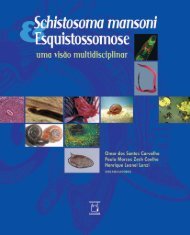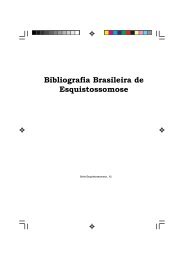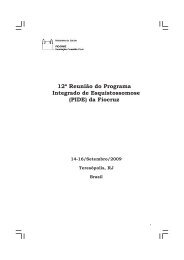English pdf, 1.64Mb - World Health Organization
English pdf, 1.64Mb - World Health Organization
English pdf, 1.64Mb - World Health Organization
Create successful ePaper yourself
Turn your PDF publications into a flip-book with our unique Google optimized e-Paper software.
SchistosomiasisEcology and transmissionThere is a clear need for markers to assess transmission, especially in areas of low endemicityand in pre-elimination foci. These areas also need to be examined regarding the evidencethat some feral animals can act as reservoir hosts, at least for S. mansoni. Methods to assesscercarial density and to detect early-stage infection in snails would be very useful and wouldcomplement diagnosis in humans (and reservoir hosts) and help evaluate the details oftransmission. RS is well suited for determining snail habitats and should be used with GIS toproduce predictive risk maps and mathematical models of transmission. With regard to snailcontrol, both environmental management and use of focal chemical molluscicides should beevaluated. Apart from biological factors, social factors play an important role in transmissionin specific ecological zones, where their role should be assessed and cross-disciplinary studiespursued to better understand the dynamics.Social IssuesOverall, schistosomiasis can be characterized as a disease of poverty. However, the evidencelinking social resources, economic status, and infection at community and household levelsneeds to be better defined. These relationships can be described through quantitative as wellas qualitative analysis of changes taking place over time, taking into account the focal natureof transmission and following the migration of households/family members. Suitable sites forresearch on social and economic determinants would be locations where new water resourcesdevelopment projects are taking place and where control programmes are being implemented.Here, exploratory studies of social change could be combined with investigations of shiftsin asset ownership over time in order to make the targeting of interventions more equitableand provide tools for measuring impact of interventions. Furthermore, such studies couldexplore how control programmes can respond to vulnerability, which constrains people’sability to seek health care, cope with illness and suffering, and adhere to therapy schemes.Understanding the contexts and processes that create vulnerability to infection, weakenresilience, and compromise equity in access to diagnostics, health information, treatment andthe benefits of preventive measures, e.g. safe water supply and sanitation, necessitates an ecobio-socialapproach. Research using this approach needs to address micro- as well as macrolevelsof analysis and be sensitive to asymmetries of gender, age, occupation, ethnicity, andincome level.The recognition of ‘subtle morbidities’ in schistosomiasis creates a new platform forresearching the social and economic impacts of this disease. Community-based studiescombining quantitative and qualitative methods can explore the impact of infection onReport of the Scientific Working Group on Schistosomiasis, 2005 • TDR/SWG/07








